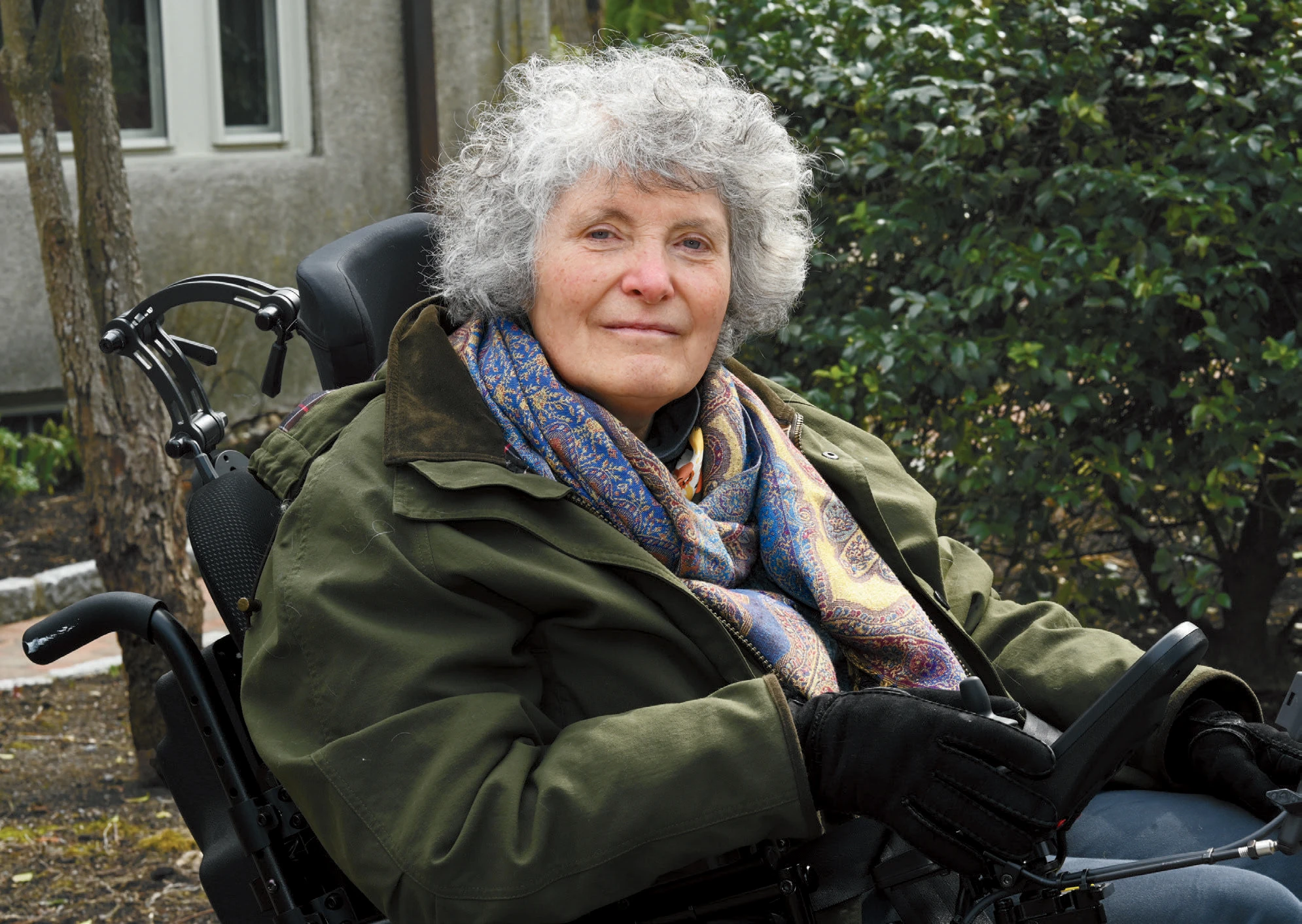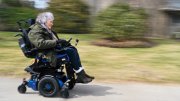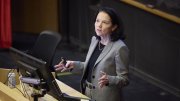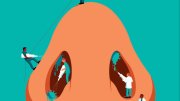Several years ago, Lisa Iezzoni, S.M. ’78, M.D. ’84, one of the most prominent researchers in healthcare and disability, decided to ask doctors what they thought about patients with disabilities. Their answers were stunning. In interviews and focus groups, physicians from across the country, in communities ranging from rural to urban, admitted to widespread resentments, prejudices, and deficiencies. Respondents included a mix of primary care doctors and specialists in fields like rheumatology and neurology, which are more likely to serve patients who need accommodations.
The discussions were held by video conference, and on their screens, physicians could not see that Iezzoni, who has multiple sclerosis, was sitting in a wheelchair.
Some described denying care or trying to rid their practices of people with disabilities; many acknowledged that their buildings were inaccessible or that their exam rooms lacked accommodations, such as height-adjustable exam tables and weight scales for wheelchair users. Some reported sending patients to be weighed in a supermarket, a grain elevator, a zoo, or a cattle-processing plant. They complained about the extra time—“unreasonable,” “unacceptable”—and costs associated with seeing disabled patients. “A disruption to the clinic flow,” one specialist called them. “An entitled population,” another said. “They can create a big thing out of nothing,” said yet another.
In 2019, informed by data from the focus groups, Iezzoni launched a nationwide survey of more than 700 physicians. Its results were equally stunning. Three decades after the Americans with Disabilities Act (ADA) began requiring equitable healthcare, only 41 percent of doctors reported feeling “very confident” about their ability to provide it, and 36 percent acknowledged knowing little or nothing about their responsibilities under the law. About 57 percent “strongly agreed” that their practices welcomed patients with disabilities.

Iezzoni and her coauthors presented these findings in a series of journal articles. In the national media, the research caught fire. The New York Times published a detailed article (“These Doctors Admit They Don’t Want Patients With Disabilities”), as did CNN and Forbes. NPR and PBS produced lengthy segments. Iezzoni says, “It really hit the big time.”
There is some irony in that, because the survey results merely confirmed what many of her previous studies had already found. For more than a quarter century, Iezzoni—professor of medicine at Harvard Medical School (HMS) and a core faculty member at the Mongan Institute, based at Massachusetts General Hospital—has been documenting the substandard care and routine disparities and disrespect that patients with disabilities encounter in clinical settings. The difference is that nearly all of those previous studies explored the patients’ perspectives, using their words and experiences. Iezzoni’s research primarily focuses on people with mobility problems, but it also includes those with chronic illnesses, psychological disabilities, and sensory impairments like deafness and blindness. According to an estimate from the Centers for Disease Control and Prevention (CDC), 73.4 million American adults have some form of disability. “But it’s only when I started publishing about doctors,” she says, “that everyone perked up.”
Still, one finding from the physician survey took her aback: 82 percent of doctors said that people with disabilities have a worse quality of life than those without. But that’s a misconception. “Everybody has hard things and easy things, good and bad things, about their lives,” Iezzoni says. “It’s possible for somebody with a disability to hold two truths that might seem inconsistent but are able to coexist. One truth is that they can’t walk, but the other truth is that they have a good life.”
That’s been the case for her: after almost four decades of using a wheelchair, she says, “It’s just the landscape I live in now.” In 1999, social scientists Gary Albrecht and Patrick Devlieger examined this phenomenon in a landmark paper titled “The Disability Paradox.” They found that the majority of people with “serious and persistent” disabilities rated their quality of life as good or excellent. “Most people with disabilities don’t view their lives as tragic,” Iezzoni says. The idea that so many of their doctors do—and that it might influence the care they provide—alarmed her.
As she explains all this, she’s sitting in the sunny kitchen of the home she shares with her husband, Reed Drews, A.M. ’79, M.D. ’83, a hematologist and medical oncologist at Beth Israel Deaconess Medical Center. The couple got married in medical school, and he, too, is an HMS faculty member. It’s a bright and bracingly cold winter afternoon, and Iezzoni’s shoulders are wrapped in a sumptuous brown shawl. Somewhere in the house, two cats are hiding under the furniture.
In person, Iezzoni exudes a bright energy. She’s 70 but seems younger. There’s an unhurried warmth to the way she speaks and the way she listens. Throughout the house, the walls are decorated with her paintings, a lifelong hobby: in vibrant pinks and blues and greens, they depict seascapes, city parks, and still lifes of fruit and flowers. Her study occupies the top floor, a broad space with windows in all directions, which she and her husband renovated to accommodate her needs when they bought the house. A motorized chair lift in the stairwell takes her up, with a battery-powered scooter waiting on the landing. There’s a kitchenette off to the side and a fully accessible bathroom. She does most of her writing at a big L-shaped desk in the middle of the room. Everything feels comfortable and welcoming. “So, why should you view my quality of life as worse?” Iezzoni says, smiling. “People with disabilities, most of us figure out how to adjust to our lives.”
“Spooky Sensations”
Originally, she had wanted to be a doctor. This is a core part of her biography, which Iezzoni has shared with many different audiences over the years. It’s a story about how opportunity and misfortune can be deeply intertwined, how fulfillment can emerge from sorrow, how a happy life is often built on rocky terrain. It’s also a story about how she lost one calling and found another, and how outright discrimination altered—but did not, ultimately, determine—her path.
One of four sisters, Iezzoni grew up mostly in Delaware. Her father was a pediatrician, and when she was a small child, he kept a practice in the family’s home. At first this was a deterrent against any medical ambition: Iezzoni’s earliest memories are filled with the wails of young patients echoing from downstairs. When she arrived at Duke University as an undergraduate, she chose anthropology as her major and briefly mulled a career in art history or paleontology. But a three-semester health policy course caught her interest and steered her back toward the medical world, and she enrolled in a master’s program at the Harvard School of Public Health (HSPH). When her professors encouraged her to think about medical school—it would “open doors,” they told her, and she’d be a good physician—she started warming to the idea. For months, she recalls, she went home after class to her tiny studio apartment on Commonwealth Avenue and sat at the dining table, staring at a yellow notepad with a line drawn down the middle, charting the pros and cons of becoming a doctor. The training would be expensive and difficult, and it would mean catching up on a lot of missed coursework, but practicing medicine offered a chance to help people directly, and that was something she’d discovered she wanted.
In the end, the pros won out. The summer after graduating, Iezzoni joined Harvard’s “special student premedical curriculum,” packing two years’ worth of courses—chemistry (organic and inorganic), calculus, physics, biology—into 12 months. To save money, she moved into Dunster House and helped cater social functions, baking cookies, making eggnog, and running to the store to pick up enormous wheels of brie. Then, in the fall of 1980, she started classes at HMS.
That first semester was when everything turned. During the previous four years, Iezzoni had occasionally experienced what she describes as “spooky sensations”—a burning in her thighs that felt like “hot branding irons” or a sudden feeling of not knowing where her legs were as she jogged along the Charles River. At her father’s urging, she had gone to the University health clinic, and the young doctor there recommended she see a neurologist. But he hadn’t appeared too worried, and the symptoms always receded, so Iezzoni never followed up. The summer before she started medical school, she took a vacation to Scotland and the Outer Hebrides, roaming the hills and cliffsides in the misty quiet.
Back on campus afterward, though, her symptoms became impossible to ignore. The burning sensations returned, and her disorientation intensified. She started bumping into trees and parked cars. On a Wednesday during her first-semester finals, she finally visited a neurologist, who gave a preliminary diagnosis of relapsing-remitting multiple sclerosis (MS), and by January she had the official confirmation.
Four decades later, Iezzoni says, she remembers her medical school experience “in shades of gray.” Her illness cast a shadow—of worry, uncertainty, sadness—but what truly darkened those years was the treatment she received. As soon as HMS administrators learned she had MS, she says, they reassigned her to a new adviser, a psychiatrist who at their first meeting snapped, “I’m not here to be your friend.” As Iezzoni began using one cane and then two to help her get around, professors and supervising physicians questioned her abilities and discouraged her plans to practice medicine. During one clinical rotation, a surgeon told her she’d make a “terrible” doctor. During another, an attending physician sent a resident to spy on her and accused her of being lazy, even though she had completed her full quota of work.
During a student dinner late in her third year, she was seated next to the leader of a Harvard teaching hospital. When she asked for his advice about her future career, he answered that there were “too many doctors in the country right now for us to worry about training handicapped physicians,” Iezzoni recalls, quoting him. “If that means certain people get left by the wayside,” he added, “that’s too bad.” The response stunned her. Despite everything, she’d been planning to apply for a residency in internal medicine. “I still didn’t realize that the medical school was going to literally refuse to write a letter of recommendation for me,” she says. “But they refused.”
Iezzoni’s medical career was over, but she still needed to earn a living. So, she turned to research. With the help of Howard Hiatt, former HSPH dean, she found a job with a Boston University health policy group that was studying major changes to Medicare’s payment system. It was highly visible research, involving important questions of fairness and quality of care, and she worked at it furiously, rising quickly through the faculty ranks at BU and then HMS, where she was hired in 1990—six years after graduating and the same year that the ADA was signed into law. In part, her productivity was driven by fear. “I was terrified of being fired because I was disabled,” she says. “And so I wrote paper after paper, which is the currency of promotion.” In 1998, she was named a full professor.
Finally, she took a breath and allowed herself to wonder, for the first time, what kind of scholarship might be the most meaningful to her. “And that’s when I started thinking about doing disability research,” she says. Until then, she’d never spoken publicly about her disease, and rarely with colleagues and friends, even as she began using a battery-powered scooter and then a motorized wheelchair. “I came out of medical school with one big message,” she says, “and that message was that I was a failure. I was a failure because medicine couldn’t cure me, and because I was a failure, I should never talk about my MS.” Now, she started talking.
“I Still Fight My Health to Try”
A new kind of research began pouring out of her, blending data analysis with qualitative interviews that harked back to her undergraduate days studying anthropology. One of her first papers on disability, published in Health Affairs in 1999, called for expanding health insurance and Medicaid coverage to include accessible home renovations and assistive devices like battery-powered scooters that help disabled people participate fully in the world around them. But the article also presented an evocative firsthand account from a retired housekeeper who was raising two grandchildren despite a multitude of ailments: emphysema, insulin-dependent diabetes, congestive heart failure, seizures, obesity, and arthritis. “We have to call ourselves ‘disable’ because we cannot do the things that we used to do,” the woman, Erna Dodd, told Iezzoni. “We are helpless in some ways, but I still fight my health to try.”
Dodd’s story was one of the dozens later included in Iezzoni’s book When Walking Fails (2003). The culmination of years of fieldwork supported by a research award from the Robert Wood Johnson Foundation, it’s partly an examination of history and health policy and partly a collection of down-to-earth advice on navigating insurance and improving mobility. But it’s also a deep and intimate look into the “parallel universe,” as one reviewer phrased it, of people with disabilities. In illuminating detail, Iezzoni explored the emotional and physical adjustments people make when their legs cease to carry them, as well as their nuanced attitudes about identity and self-definition. She described people’s jobs and their lives at home with loved ones and their feelings of frustration or distrust—or defiance—at society’s prejudices, strangers’ disregard, and doctors’ often inadequate responses. Her own experiences are woven throughout the text.
“She’s a remarkable scholar,” says Michael Stein, J.D. ’88, the executive director of the Harvard Law School (HLS) Project on Disability. Iezzoni’s friend and collaborator, Stein is an expert on disability law and policy who teaches at HLS and the Harvard Kennedy School (HKS). “The way she managed to flip the script, from being unwanted and not permitted to advance, to then being a leader within a research field—that’s important,” he says. “Her work has led the way for many others.”
One of those others is Colin Killick, M.P.P. ’18, executive director of the Washington, D.C.-based Autism Self Advocacy Network and former director of the Massachusetts-based Disability Policy Consortium. “Lisa really changed my thinking about disability,” he says. During his graduate studies at Harvard, he worked as a research assistant on a study co-led by Iezzoni. “To see people like her doing this incredibly innovative and important work,” he says, “not even in spite of their disability but because of their disability—because their disability actually gave them critical insights—that’s so important for somebody like me, who’s still finding my identity as a disabled person.”
After Iezzoni’s physician survey findings were published, Killick wrote a bill, which has been introduced in the Massachusetts State House, aimed at preventing healthcare discrimination and “enshrining in state law,” he says, “the principle that the lives of people with disabilities are every bit as valuable and as worth living as anybody else’s.”
Cheri Blauwet, a sports medicine physician at Brigham and Women’s Hospital and chief medical officer at Spaulding Rehabilitation Hospital, considers Iezzoni a mentor and a friend. A former Paralympic wheelchair racer who was paralyzed in a farming accident as a toddler, Blauwet started medical school in 2003, a full generation after Iezzoni, and never questioned that she would be able to practice. Now an HMS associate professor, she met Iezzoni during her residency at Harvard. “Lisa gave me a pragmatic reality check about being a very busy medical trainee and a wheelchair user,” Blauwet says, “and the importance of taking care of my health.” Iezzoni also helped her think through her options for specialty training, “to make sure,” Blauwet says, “that the programs that I ranked were ones where I felt reassured that the leadership would have my best interests in mind. She helped me have a bit more of a discerning eye.”
Iezzoni spoke to many women who’d never received a Pap test, because their doctors had never taken them out of their wheelchairs for a pelvic exam.
The “Pain Point”
Over the years, Iezzoni’s research has followed several broad themes. One is cancer care. She found that patients with disabilities are less likely to receive aggressive treatment and uncovered troubling disparities in screening, particularly for breast and cervical cancer. Women who cannot stand have trouble accessing standard mammogram equipment, and the frequency of mammograms drops significantly, she found, as their disability becomes more severe. And while 80 percent of women without disabilities report having regular cervical screenings, for women with mobility limitations, it is only 68 percent. Iezzoni spoke to many women who’d never received a Pap test, because their doctors had never taken them out of their wheelchairs for a pelvic exam. She says, “I heard that over and over and over again.”
In studying reproductive health, Iezzoni found that women with major mobility problems were 70 percent less likely than other women to be asked about contraception during routine office visits, because of physicians’ erroneous assumption that they weren’t sexually active. In a study of prenatal care for women with problems walking, patients reported not being routinely weighed on wheelchair-accessible scales during their pregnancies, and a few said they were never weighed at all. In other studies, Iezzoni has looked at birth outcomes, maternal mortality, postpartum depression, breastfeeding, and physical adjustments for childcare—and across the board, she has found, women with disabilities receive worse care and face higher maternal mortality rates, especially women of color. She interviewed disabled women about their advice to clinicians about providing better care and to each other about negotiating the challenges of pregnancy. In a sobering 2015 study of societal views, she documented the reactions of strangers in public to pregnant women with disabilities: stares and curious comments that were occasionally positive, but more often intrusive, insensitive, or outright hostile.
“Lisa gets at that pain point,” says Monika Mitra, director of the Lurie Institute for Disability Policy at Brandeis University and frequent partner on Iezzoni’s reproductive health research (the two have written nearly two dozen papers together). Iezzoni, she says, was one of the first scholars to give significant attention to this subject, building a body of evidence that helped open up the field. “There was a real vacuum, largely driven by this perception that disabled women cannot, or should not, have children,” Mitra says. “Lisa’s work has sparked these important discussions about not just the maternal health of women with disabilities, but also the necessity of better training for healthcare professionals and the need to systematically address these biases.”
Several of Iezzoni’s other papers fall under a different kind of theme—they were inspired by her late friend Michael Ogg, a man she met by chance in 2009 on a train platform in Princeton, New Jersey. Her scooter had malfunctioned mid-journey, and after the conductor assisted her off the train, she was stuck in place, unable to move on her own. Ogg, who was also disabled, wheeled over to try to help. Despite her protestations, he stayed with her for 45 minutes, until night fell and Iezzoni’s driver arrived.
After that the two became close friends and unexpected collaborators. Ogg was an Oxford-trained physicist who’d been a professor before he was diagnosed in his early 40s with primary progressive MS (a form of the disease that advances more steadily, rather than in sudden bursts, as in Iezzoni’s case). He was divorced and lived alone, and his sometimes harrowing experiences with the healthcare system became jumping-off points for her research. After doctors missed a tumor in his lower abdomen for months—even as his health worsened dramatically and the mass grew to 15 pounds—Iezzoni wrote about the dangers of “diagnostic overshadowing,” a kind of tunnel vision in which clinicians ascribe any new symptoms to a patient’s underlying chronic condition. (Ogg’s physicians had initially just assumed that his MS was getting worse.) Iezzoni’s book, Making Their Days Happen (2021), about the paid personal assistants who enable people with disabilities to live independently, was prompted in part by witnessing Ogg’s interactions with his hired caregivers. She interviewed dozens of caregivers and their clients, exploring issues of health policy and civil rights, as well as the emotional complexities of personal care: intimacy, trust, conflict, respect.
She encouraged Ogg to tell his most troubling stories himself, including a 2017 ordeal in which he was held in a nursing home for three months against his will by his geriatrician. The staff there neglected his basic needs and he became so sick he had to be hospitalized and never fully recovered, remaining essentially bedridden for the rest of his life. He wrote about the experience in a 2019 Health Affairs article.
Ogg died in 2023 from a lung condition, and Iezzoni still can’t speak about the loss without tearing up. “It’s hard to think about the last part of my research career without thinking about my friend Michael,” she says. His was one of those lives that was indisputably worth living, she notes: he maintained robust friendships and an active intellectual life. He was able to spend time with his two young children and had close relationships with family members back home in England. Whatever his quality of life looked like to the outside world—or to his doctors—to him it was precious, and more than once he fought hard to keep it. “I miss him,” she says, “He always helped me understand the world better.”
***
On a sunny day in mid-March, Iezzoni arrived at HKS to deliver a guest lecture in Michael Stein’s class, Disability Law and Policy. The course typically draws a high proportion of students with disabilities, Stein says, and during her hourlong presentation, students asked questions about research methodologies, socioeconomic factors, and the ADA. In PowerPoint slides, Iezzoni laid out the basics of her cancer and reproductive health research, as well as the survey of physician attitudes. When she reached the statistic about 82 percent of doctors believing their disabled patients had a lower quality of life, a hard silence filled the room.
Finally, Iezzoni turned toward the future. A new slide clicked onto the screen behind her: “We seem to be at a tipping point,” it asked, “but what happens now?”
The answer to that question worries Iezzoni. She told the class a story: in 2024 the federal government finally proposed concrete rules (including enforcement mechanisms) for making medical diagnostic equipment accessible, as mandated by Section 504 of the 1973 Rehabilitation Act. It’s a disability civil rights law that predates the ADA by nearly two decades—and a law that, like the ADA, has never been fully followed. In compiling these rules, the Department of Health and Human Services had relied on Iezzoni’s research and on her work 12 years earlier as chair of the U.S. Access Board’s advisory committee on accessibility standards for medical equipment. “People with disabilities have been waiting for this for 50 years,” she’d said in an interview the day before her lecture. “For some reason healthcare has been among the most backward environments, in terms of making itself accessible. Movie theaters are accessible, sports stadiums are accessible, transit is accessible. But healthcare facilities—no.”
Will the rules proposed last year survive? “I don’t know,” Iezzoni told the class. She shook her head and gave a rueful smile: “I don’t know.” The new Trump administration’s hostility toward diversity—including disability—is an ominous sign, and lately, Iezzoni has ramped up her advocacy work. To her, the precarity of these rules feels like a metaphor for disability healthcare rights as whole: urgent, fragile, uncertain, and, after all the decades of struggle, so tantalizingly close to fulfillment.








